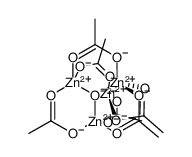| Structure | Name/CAS No. | Articles |
|---|---|---|
 |
zinc acetate, basic
CAS:12129-82-7 |
|
tetra-μ3-oxohexazirconium Structure](https://image.chemsrc.com/caspic/181/189028-53-3.png) |
O′)](2-methyl-2-propenoato-κO)tetra-μ3-oxohexazirconium
CAS:189028-53-3 |
|
 |
bis(μ4-oxo)hexakis(μ3-pivalato)hexakis(μ2-pivalato)octacobalt(II)
CAS:301663-94-5 |